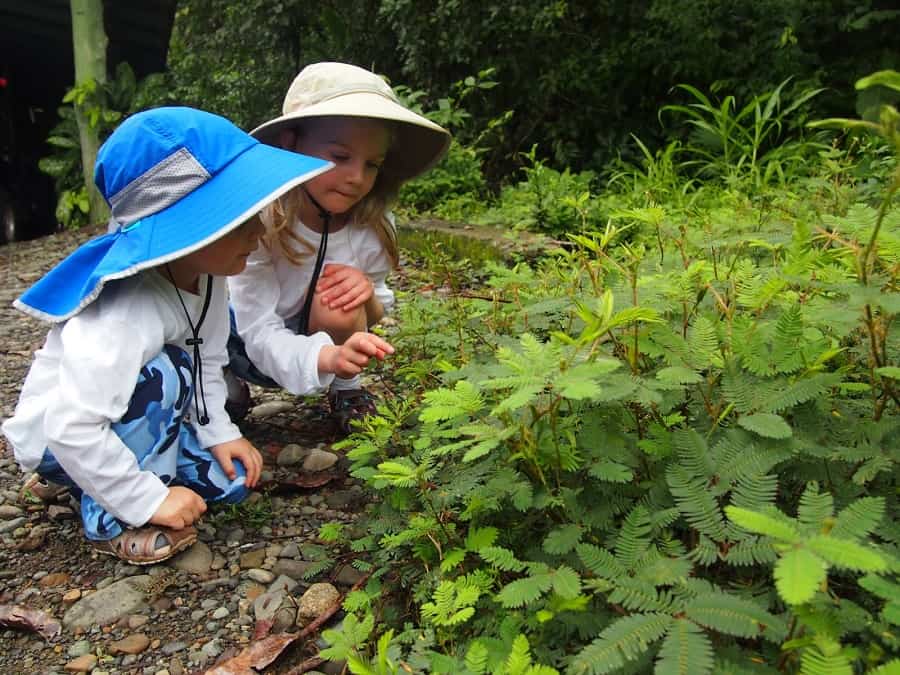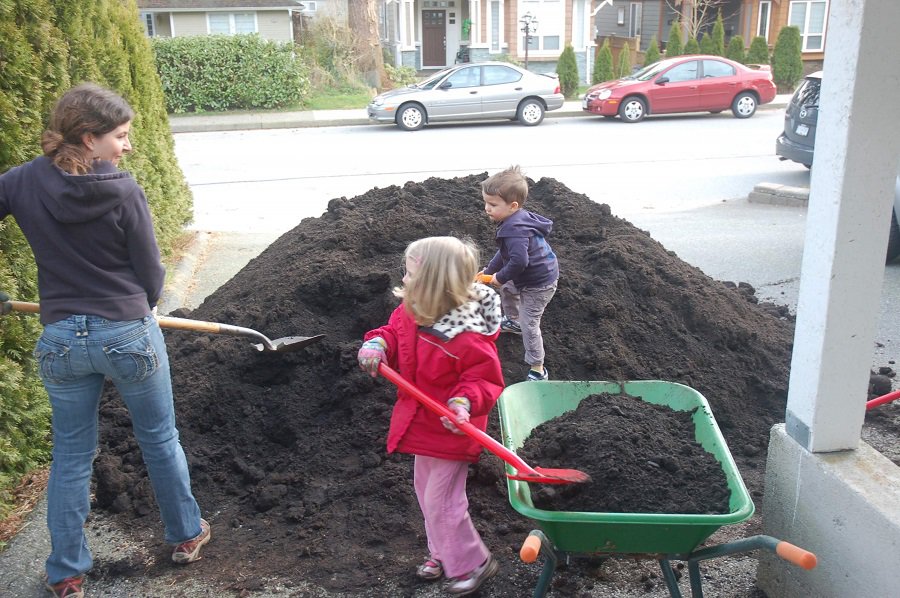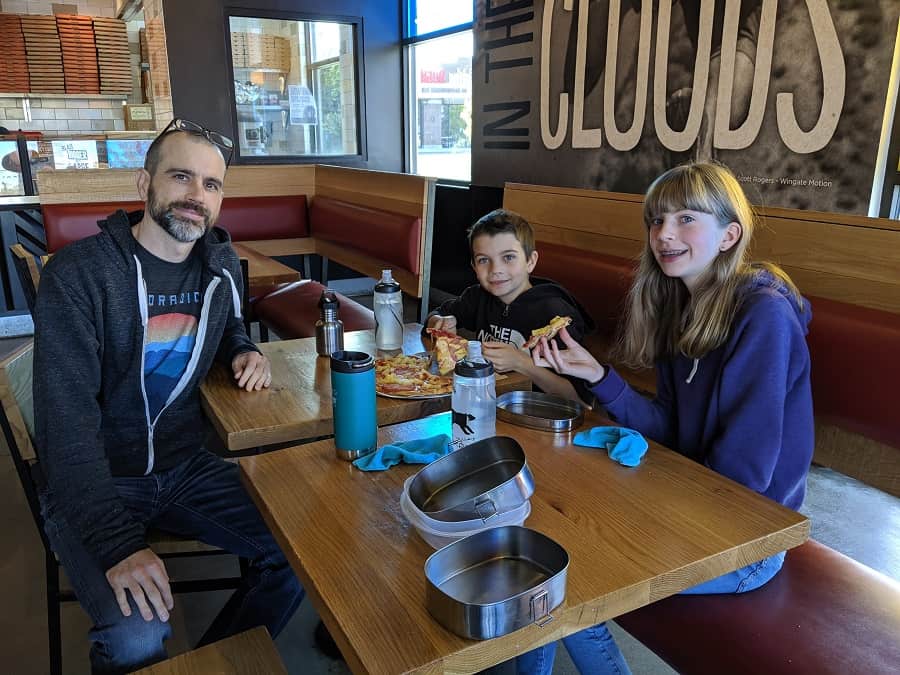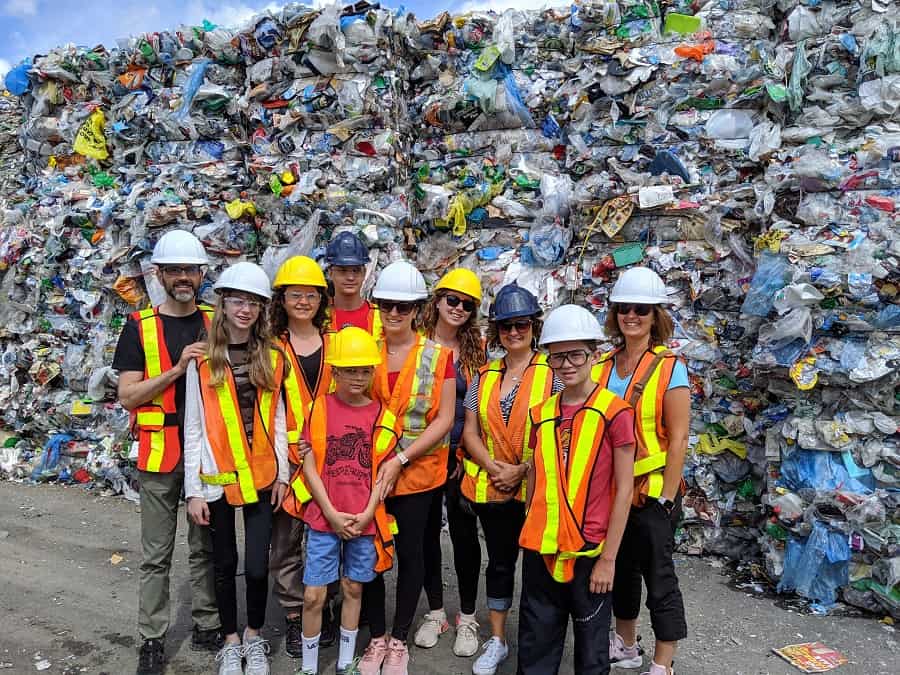It is more important now than ever to raise an environmentally conscious next generation. Children are the future so let’s be sure to raise them with a respect of nature!

To raise environmentally friendly kids you can:
- teach by example
- spend time in nature
- story telling about environmental activists
- make green food choices
- give experiences as gifts
- consume second hand
- practice active transportation
Teach By Example
As with all things in parenting, the best way to teach a behavior is to model the behavior. These little mirrors that we call children have an amazing ability to mimic the good and bad things that we do. So straight off the bat, I’d say be honest with them about the actions you would like to see as a family and show them that you are also working towards positive changes.
Nobody is perfect. Making the environmentally sound choice is not always easy and is not always expected. Just do the best you can, explain the choices and the challenges and maybe together you can come up with a plan to make changes.
If you want your kids to spend time outside in nature, it helps if they see YOU spending time outside in nature. If you want your kids to stop begging for all the new toys and gadgets that are advertised to them, then you have to stop purchasing all the new toys and gadgets that are advertised to you!
Once you start preaching to them about conserving energy, you have to be prepared for them to preach right back as soon as you leave the room without turning off a light! This is good stuff, just be ready for it!
Activities in Nature
Respecting nature is one of the easiest ways to get kids to be environmentally aware. It can start in your backyard with a garden or regularly going for a hike on a trail. As you spend time you can discuss the plants and trees around you and what they need to thrive. You can pay attention to how you feel when you come inside after being outside for a long period of time.
It might take some convincing to get outside but usually kids will love it and then need convincing to go back inside!
Forest Bathing
Forest bathing is a very easy thing to do with kids if you have access to a forest or green space. Kids naturally make good forest bathers as they wander aimlessly through a forest.
Forest bathing is not meditation and it is not hiking but it is sort of like something in between. You do not have to sit and be perfectly still, you can wander around slowly and just observe the natural setting around you. You are not hiking with a destination but rather moving towards any tree or creek or bird that catches your attention.
The act of forest bathing has so many physical and mental benefits. If you are able to spend one and a half to two hours in a forest with your kids, you will all experience the rewards. Do not bring your phone, do not try to document that cute things that the kids are doing. Just be present as best you can, breathe deeply and smile. You can ask your children to move slowly, pay attention to the sounds and the smell and the sights.
Forest bathing is great for reversing some stresses related to screen time and allow children to reconnect with nature. The physical benefits from one forest bathing session can last up to one month!
Volunteer At The Local Food Farm
There is an amazing amount of learning that can be done at a local food farm. Often small community farms allow volunteers to spend a day digging and planting and harvesting with kids. Many also offer seed exchanges, bee workshops, soil health lessons and so on. Even if the kids don’t participate but hear about it through your participation, they will gain so much from it.
Many years ago, I was able to take my kids (ages 6 and 8) to our local food farm where we dug compost into wheel barrows and dumped them in the garden beds. This was an amazing experience that the kids have not forgotten 9 years later. They were amazed at the giant worms we found and learned about the worms’ vital role in producing that soil. We got familiar with many little seedlings that needed the compost and the mulch that was used on top of it all.
Mostly it was just a fun day outside feeling good about being part of something even just for a short time. Exposing kids to the fact that local food farms exist is a great way to learn about where food comes from and that they have an option to be involved later in life.
Raise Awareness Through Story Telling
Most parents spend time with their kids reading books at bed time or telling stories. Kids love to hear an exciting story about a hero and a character that tries something different to fix a problem. These stories don’t always have to be fiction!
Take a bit of time to learn about some of the amazing people that are taking action to make changes to improve the health of the environment. Just a few web searches can arm you with great stories about the great stuff that is happening in the world to stop climate change, improve our oceans, decrease waste and bring people together.
The following are only three examples of activists that have a great story to tell:
Rob Greenfield
Take for instance Rob Greenfield. If you haven’t heard of him yet, look him up, he is living radically to show us that it is possible. This guy has an amazing story that kids would love to hear about. All of this belongings fit into his backpack and he has traveled across the United States several times on a bicycle. Rob started a movement to end food waste and hunger in the United States.
For one month, Rob decided to consume food as a typical American and he wore every piece of trash he created through food packaging. He was known as “trash man” as he walked around New York City with 7 full clear garbage bags full of food packaging waste. He normally lives and promotes a zero waste lifestyle but wore the trash for a month to raise awareness.
For a period of time he lived in a tiny home where he composted and repurposed his own poop (kids will love that!). He also grew all the food that he ate for a year of his life just to see if it could be done. He did not eat one thing all year that came from a store or was purchased.
If you are OK with showing photos to go with your story telling, you can login to his Instagram account to see some of the amazing things he is doing. And if you prefer, you can also start or end your story telling with a YouTube video to show him in some of his various pursuits.
My twelve year old son loves seeing and hearing about all of Rob Greenfield’s adventures (including turning a stolen bike into a way to donate 50+ bikes to children in need) and my son has really related these things to his own life and is trying to take better care of the world around him.
Zero Waste Home
There are also many stories that can be told about zero waste influencers like Bea Johnson from Zero Waste Home. Kids love to hear about people that live a little differently from them and why they do it. When you learn a bit about Bea and her family, you will see that they are very good at refusing to bring waste and packaging into their homes. Even from school when teachers want to do art projects or ask the kids to have specific materials for projects, Bea will question that and find alternative ways to get the lesson without the trash or recycling.
Bea is the founder of the zero waste movement and is teaching people about making their own cleaning and hygiene products (and bringing containers to the store to purchase the materials to make them). She started an international bulk finder app for your mobile that will help people around the world find the stores that will sell products without packaging.
This might not sound like something kids want to hear about at story time but give it a try. You might find that kids are very interested and ask many questions. But be prepared to answer how you plan to make changes in your own home if there is a change you can be making! You can discuss with them what the challenges are for your situation and why you purchase items the way that you do. And one thing I’ve learned is that simply admitting that there is a better way to do things is a great instigator for figuring out how to make the change.
Greta Thunberg
A list of inspiring activists to tell your kids about wouldn’t be complete without Greta Thunberg. Her story is simple but has touched the lives of millions of people around the world. She has brought awareness to the global issue of climate change and has sparked many other young people to demand change.
Greta has displayed incredible bravery in standing up and speaking at multiple climate rallies as well as the United Nations Climate Change Conference. She writes her own speeches which have gone viral raising awareness to millions of people.
Greta tries to live a low carbon lifestyle and she has been named TIME magazine’s person of the year in 2019 as well as in the list of the top 100 most influential people in the world.
There is a great children’s picture book that you can read to younger kids about Greta’s adventure through a touching allegory. I prefer this book to another picture book called “Our House Is On Fire: Greta Thunberg’s Call To Save The Planet” which is a bit scary if you ask me.
Greener Food Choices
One of the biggest areas of carbon emissions has to do with food production. Typical agricultural techniques have become more problematic as the demand for food increases. With deforestation, pesticides and fertilizers being common practice carbon emissions are at an all time high. While at the same time nearly a third of the world’s food is wasted.
But there are choices each person can make to reduce the demand for dirty agriculture and to reduce food waste.
Simply talking to older kids about the choices you are making with food can bring awareness. You don’t have to be super strict or scary about it, just be open and honest.
Reduce Red Meat In Your Diet
This topic tops most personal carbon footprint reduction action lists. Beef, lamb and pork are considered red meat and the cost of producing them is high. For many beef farms, forests are cut down to make space for the cows as well as the forests that are cut down to grow the food to feed the cows. Unfortunately these lost forests are not doing the job of pulling carbon out of the atmosphere and at the same time cows are putting more carbon into the atmosphere. It’s like a double whammy!
Not only that but cows typically need antibiotics, and growth hormones are used to increase the output of meat. These chemicals pollute the soils and waterways downstream from the farms. Not to mention the overgrazing of the fields causing erosion issues.
Simply put, reducing your intake of beef is one of the best things you can do to make a difference. Less demand should equal less production.
Eat Local
Food that is grown closest to where it is consumed is generally the healthiest. This food travels less distance and should therefor be fresher. Food that is fresher has more nutrients. When the food doesn’t need to travel as far, it can be picked riper and doesn’t require wax or preserving.
It is great to bring kids to a local farmers market so they can see what food can grow close to home. Produce looks so beautiful at the market and in a cloth bag. Hopefully this will entice the kids to eat it on their plates as well!

Lessons Through Backyard Composting
If you have a backyard you can have a compost! Composting is actually very easy and fun for the kids to watch. All you have to do is keep your vegetable and fruit scraps in a bowl and take it out to the compost bin a couple times a week (depending on how big your bowl is). Then every once in a while, add grass clippings or dead leaves from trees or pruning. Together you can mix the compost with a stick to turn it.
After some time, you will find the compost pile heats up and just eats up anything you put in it. It is amazing that you can keep adding to the compost and the pile doesn’t grow! When you are ready to use some soil (after a few months of composting) you can dig up the pile, lay it out on the ground and put the un-composted bits back into the bin. The rest is super rich soil (with many worms!).
This part is always fun to get the kids involved in. It can be stinky and gross but kids love that stuff!
Reduce Food Waste
We can all try to eat all the food on our plates, all the leftovers from the fridge and finish what is in the cupboards before their expiry. But if you want to really engage kids in the topic of food waste, check out some of Rob Greenfield’s YouTube videos.
A New Way To Dine At Restauarants
Restaurants can be a special time with families. With just a few little tricks you can improve the waste involved at restaurants.
When you are ordering food for your kids it is good to get into the habit of saying “no plastic cups or straws please”. I usually have good success with this but occasionally you will come across a restaurant that will give you a plastic cup with a lid anyways. If you know this ahead of time, you can order it as if it were for you.

When I go to a restaurant, I usually bring some food storage containers for leftovers. It is so much easier to pack up the food myself instead of waiting for someone else to go to the back to do it. Also it gives me the chance to separate things the way I would like them (I bring different sized containers that stack inside each other). And most importantly, you will avoid the plastic / styrofoam / “compostable” to go containers. (The containers that are labelled compostable are usually the type that need to go to a special facility to be composted, they usually end up in the landfill)
You can also bring your own cloth napkins and neatly stack the ones that you find at the table so they can be reused. Hopefully they will actually get used by someone else.
Zero Waste Lunch
I recommend investing in a good lunch kit. I love the leak proof stainless steel ones that wash so easily in the dishwasher. The containers often have different sections that you can fill with left overs, sandwiches, vegetables, fruit, popcorn or left overs. If the food needs a fork, I love a good lightweight spork!
There are so many ways to pack a zero waste lunch. Kids get used to grabbing their container and snack bag each day and clean up is a cinch.
Speaking of zero waste, find out if there is a waste stores in your area. I love the zero waste shops that I have been to because I don’t have to fill my recycling bin with the packaging from the foods that I purchase. Not only do these zero waste stores have dried foods like rice and flour and pasta, but they have vinegar, oil, eggs, mayo, cheese, frozen foods etc. You just have to plan a little bit before you go so that you have the correct containers for each thing you want to buy.
Unfortunately the zero waste stores have had to change their model due to COVID-19 issues but they seem to be working through it and coming up with some great solutions like container deposits.
Gift Giving Is Changing
I think we all need to reconsider the way we celebrate people on their birthdays. Most people fall into the trap of purchasing all kinds of gifts for their children to show them how much they love them. Each year the pile of gifts grows and the parties get more elaborate.
I have seen a trend in gift giving over the past few years that I think is good. People seem to be giving the git of experiences. Taking the birthday child for an outing, giving a gift card for a useful store.
Purchase Used Toys
Children’s toys and games are tricky, it is not always easy to find exactly what you are looking for in a used shop or Craigslist / Facebook Marketplace. If you can – scour the swaps, ask friends with older kids, TRY to find toys second hand! LEGO is a great toy that can often be found second hand but you might not get the exact set that you wanted.
But the good news is you might find great toys that weren’t on your radar that your kids will love. Usually people sell the good stuff on these marketplace websites so you will probably end up with something great and unexpected.
Be sure to present the new second hand toy in a positive light. Be proud that you scored such a toy and they kids will love it even more. The attitude that we have towards second hand stuff will rub off on them so make sure to set them up for life!
Active Transportation Can Be Fun
When possible try to walk / bike / scoot to school instead of driving a car. Even on rainy / snowy days it always feels great when you arrive at school via active transportation. Having the proper clothing and shoes for the weather will make all the difference.
Avoid Fast Fashion
There are so many outfits, shoes, jackets, hats online for sale second hand – always try to check these first. If you know someone with kids slightly older (or physically bigger) than your kids ask about their hand me downs. And make sure to find someone that is smaller to hand your stuff down to.
Again, kids will feel much better about wearing second hand clothes if they see you happily wearing new second hand clothes as well.
Clothing swaps are a great way to hang out with friends and gain many risk free pieces of clothing. Many clothing swaps are for both adults and children.
Recycling As A Last Resort
If you end up with some packaging, make sure to teach your kids about how to properly recycle them. The materials need to be clean, separated and sometimes flattened.

I highly recommend taking your kids to a tour of a recycling facility. We went as a family recently to a progressive facility where we learned about the value of some of the materials and saw how they were compacted for transport.
Energy Consumption In Your Home
And of course conserving energy in your home is a very easy way to bring awareness to your children. Once again, make sure you are teaching by example, and that you are doing all of the things to save energy in your home that you want your kids to do.
For example, turning off lights when you aren’t in a room and unplugging appliances like toaster and kettle when you aren’t using them. These ones are easy.
The more difficult ones might be unplugging your TV when you aren’t using it and learning how to properly charge phones and laptops (ie. not leaving them plugged in all the time, let them drain to about 20% before recharging).
Depending on the age of your kids, you might like to try an online carbon calculator together with them. There are some good ones for kids like the WWF’s carbon footprint calculator. It has great information and tips for improving your personal carbon footprint.
Kids And House Plants
Caring for a house plant (or 10) is a great way to teach kids about the symbiotic relationship between plants and people. But you can also discuss with your kids the healthy benefits of living with house plants.
There are many other ways to teach kids to have an appreciation for nature. But the most important thing to remember is to live it yourself and to have fun with the process. Kids are amazing people with so much potential, when you give them a healthy environment to thrive – their growth will blow your mind!
Recent Content
Thinking about buying a new (or used) car is a big decision for most people. It is one of the biggest purchases people make in terms of expense and ownership time. The options can be daunting...
Environmentally Friendly Funerals - It's Never Too Early To Plan
The environmental impact of a typical funeral in North America is big. Whether you choose cremation or conventional burial there is a large source of greenhouse gas emissions and pollution...
